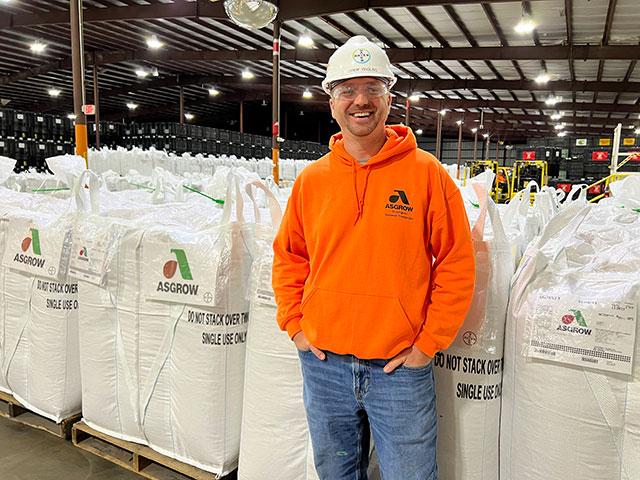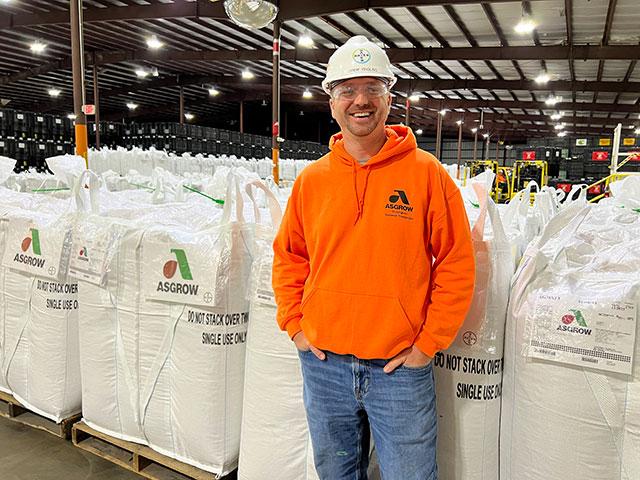Production Blog
More Than Beans in a Bag
Those mini bulk containers and soybean seed sacks soon to arrive at your farm for 2024 planting contain more than merely beans. Each one has the fingerprints of a long line of people behind the scenes.
Every so often this journalist gets surprised by what seems obvious but isn't. That's how I felt after a tour of Bayer's Stonington, Illinois, soybean processing plant this fall.
I've driven by the facility hundreds, if not thousands, of times. I knew soybeans were processed within and had a pretty good idea of what that entails. But the opportunity to look behind those doors revealed something I don't find enough of these days -- a group of people beyond proud of what they do and excited to explain the details of the process.
Drew Yingling, who has western Illinois farm roots, is the site lead. He estimated the 2.3 million units (bags) of soybean packaged here each year go through nine to 10 quality checks before being distributed to about 20 states.
"Quality is at the heart of everything we do," said Yingling. That starts in the summer months the year prior to seed production with selection of growers. The Stonington facility contracts to grow approximately 56,000 acres of soybean seed across 20 different counties in Illinois. The growing footprint consists of 550 fields across 72 different seed growers and 27 soybean varieties that span Group 2.4 to Group 4.0 relative maturity.
Ed Rohrer has been a production manager for Asgrow for 35 years. He explained that Christian County (Illinois) contains enough acres to satisfy the production capacity for this facility. Instead, production is spread out to manage weather risk. Every farmer who watched a curtain of rain stop at the neighbor's field last year understands that logic.
Selecting growers is the first chapter in the soybean seed story. Rohrer said seed growers are generally farmers who have well-managed land and machinery. They have shown the ability to be timely with harvest and follow the combine cleanout and storage protocols associated with segregated production. "We work with engaged growers that want to know how well they are doing," he said.
P[L1] D[0x0] M[300x250] OOP[F] ADUNIT[] T[]
Field inspections are conducted during the summer months to ensure purity and evaluate potential yield. Grower bins are inspected prior to harvest. There are quality checks of the seed beans while binned on the farm and at receiving. Evaluations of appearance, purity and germination rate are conducted multiple times before being considered for conditioning and packaging.
Quality tests are also done to make sure the seed meets the legal standards printed on the seed tag -- which indicates things like germination rate, herbicide tolerance and amount of weed seed. Even pallets, labels and wrappings are inspected multiple times between packaging and shipping to make sure nothing has happened in the warehouse to compromise the quality during storage.
I'm giving away my age when I say I remember the ritual of saving soybean seed -- the process of taking the bin-run beans to be cleaned and testing germination on those seeds in the spring before planting. In the days of my youth, we used public soybean varieties. Private-label soybean varieties were just beginning to become popular.
To see the automation, data collection, color sorting and overall speed of handling of a modern facility was impressive, especially when layered with these old memories.
But it was also interesting to learn there is still no substitute for human touch. Soybean see today may be quality tested in controlled lab environments with precise temperatures, humidity and moisture, but the samples are still grown out and manually evaluated by trained lab technicians.
The good news is that soybean seed appears to have come through the 2023 season in good shape and good supply in this region.
"Our growing area was really set up for success with the weather that we had as far as getting the crop in the ground in a timely manner," Yingling said, noting that 80% of the central Illinois acres were planted by May 1.
Weather also cooperated over the harvest period, which goes a long way toward ensuring desired quality parameters, Yingling added.
Every year is a little different because nature ultimately dictates the outcome, Yingling said. "One thing that never changes is our dedication to making sure we deliver a quality product and that requires a lot of teamwork," he added.
Soybean seed that isn't used for the subsequent year is not held over, Yingling said. Since it is stored untreated, leftovers (if there are any) are typically sold into the commodity stream.
The Stonington facility, built in 1981, originally employed 14 full-time workers. The Asgrow brand has roots in 1856 but became prominent after Monsanto purchased the company in 1997. Roundup Ready soybeans had been launched a year earlier. Bayer purchased Monsanto in 2018.
There have been five production expansions at the Stonington plant that have doubled bulk capacity. The plant currently runs two conditioning lines and four packaging lines with 41 full-time employees and up to 20 seasonal employees during peak seasons.
Passing a seed plant is not uncommon if you do much traveling in farm country. The shiny storage bins emblazoned with the corporate logo are easy to spot. We spend a lot of time looking into and writing about the science of breeding varieties and the farm management practices needed to grow the seed properly. But there's a whole handling process in the middle of those two things that makes seed viable.
Pamela Smith can be reached at pamela.smith@dtn.com.
Follow her on X, formerly known as Twitter, @PamSmithDTN.
(c) Copyright 2023 DTN, LLC. All rights reserved.






Comments
To comment, please Log In or Join our Community .